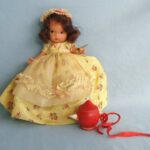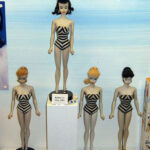Because this doll has been so popular for so long, I decided to find out where it originated and what it means. The Matryoshka doll is also referred to as a nesting doll. Its origin is in Russia. There are stories that stem from the Japanese that claim that a similar wooden doll was inspired by the work of a Russian monk. The monk made a wooden figure depicting a good-natured, bald old man thought to represent a Buddhist sage. Nesting dolls from Japan are called kokeshi. They have been around longer than matryoshki and are wooden dolls that originated as figures of Buddhist gods. The first Russian nesting doll was created in the 1890’s in the Children’s Education Workshop in Abramtsevo near Moscow. This workshop brought together skilled craftsmen and professional artists who were capable of producing and preserving the peasant folk toys and dolls dressed in regional costumes. One artist on the team had the idea of making a wooden doll that opened up, revealing a series of nested figures inside. The first one of its kind was named Matryoshka. This name is derived from the Russian female first name “Matryona”, which is associated with a robust, rustic, Russian woman. This first doll still exists and can be viewed in the Museum of Toys in Sergiev Posad, Russia.
In Russia, the word Matryoshka is associated with fertility and motherhood. The portly, checked doll on the outside represents the mother. She has the likeness of her many children painted on the smaller, inner dolls. These dolls are made entirely from natural products and are hand-painted. They can range in size from large, 15 inch masterpieces containing 40 or more smaller versions within, to tiny creations that require a magnifying glass to paint them and to see their tiny detail. They can take anywhere from 5 days to 18 months of work to complete. The painting of each doll can be extremely elaborate. Other names for these dolls are stacking dolls or Babushka dolls.
When you own a Russian Matryoshka, you own not only a wonderful piece of Russian history, but a small part of its childlike wonder and magic. It’s interesting to get a doll and have no idea how many smaller dolls are inside until you explore it for yourself. The number of nested dolls is usually six or more. They have no hands except for those that are painted on. There are many cheap versions of these dolls now available. If you want to own a truly unique doll, shop carefully so as not to buy a mass-produced version. Matryoshkas are often designed to follow a particular theme. Themes can range from fairy tale characters to Soviet leaders.
Think back to when you were a child. Did you have a nesting doll? I remember I did, and I loved it. Almost everyone has had a set of nesting dolls. Most everyone can appreciate the history and structure of these unique dolls. They are great toys for children as well as beautiful pieces of art for collectors.






